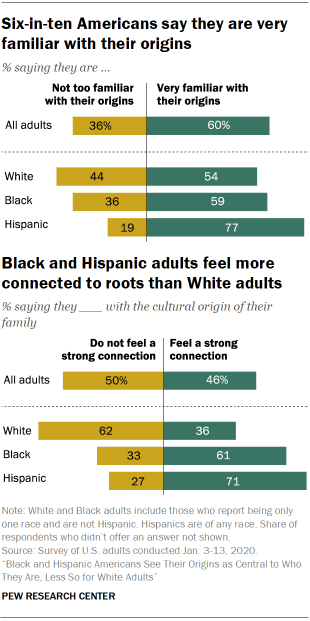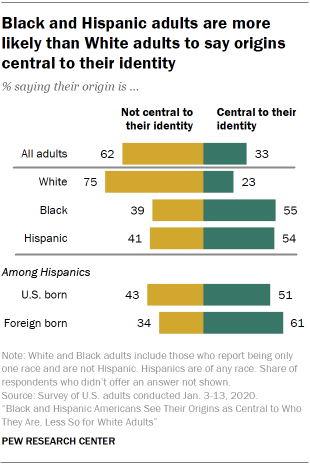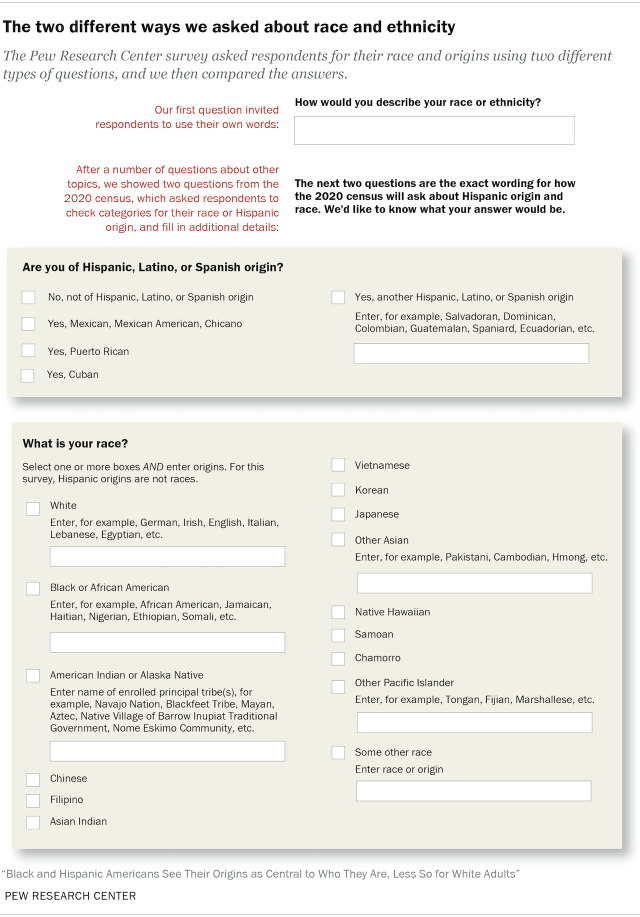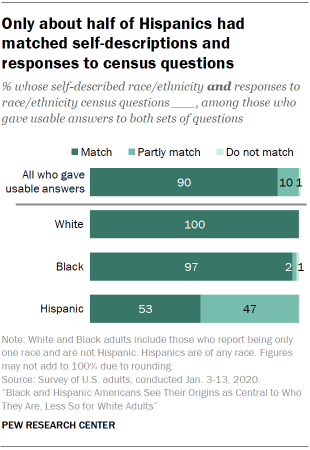About half of Americans see their identity reflected very well in census race and ethnicity questions
Pew Research Center conducted this study to better understand how Americans think of their own racial and ethnic identities and how that maps onto the race and ethnicity questions that appeared on the 2020 census.
For this analysis, we surveyed 3,535 U.S. adults in January 2020. The adults who were surveyed are members of Ipsos Public Affairs’ KnowledgePanel, an online survey panel that is recruited through national, random sampling of residential addresses and landline and cellphone numbers. KnowledgePanel provides internet access for those who do not have it and, if needed, a device to access the internet when they join the panel. To ensure that the results of this survey reflect a balanced cross section of the nation, the data is weighted to match the U.S. adult population by gender, age, education, race and ethnicity and other categories. The survey was conducted in English and Spanish.
Here are the questions used for this report, along with responses, and its methodology.
Most Americans say they are very familiar with their roots, but the strength of their attachment to them varies by race and Hispanic origin, according to a Pew Research Center survey conducted to explore themes of self-identity ahead of last year’s U.S. decennial census. Black and Hispanic adults were more likely than White adults to say their origins are central to their identity and that they feel a strong connection to their family’s cultural roots.
Overall, six-in-ten U.S. adults said they are very familiar with their origins, according to the survey. But not quite half (46%) said they feel a strong connection to their family’s cultural roots. And only a third said their origin is central to their identity.
However, Hispanic adults, especially immigrants, were more likely to be familiar with their origins than single-race Black or White adults. A majority of Hispanic and Black respondents, but not of Whites, said they feel a strong connection to their roots. And about half or more of Hispanic and Black respondents said their origin is central to their identity, but only about a quarter of Whites said so.
The online survey of 3,535 adults conducted in January 2020 included Americans of all races, but results are shown separately only for White, Hispanic and Black adults, as well as for all non-Hispanic respondents who checked more than one racial category. As with many surveys of this size, there are too few respondents who identify as Asian American, Native American or in other racial groups to draw statistically sound conclusions.
Since that survey was conducted, Pew Research Center has begun to implement plans to expand its work on race and ethnicity to better represent the diversity of people and voices in the United States. Our recent publications include a statistical portrait of Asian Americans and key Asian origin groups and other research that can be accessed on our Asian American topic page. By expanding the Asian American sample in later 2020 surveys, Pew Research was able to report specific results for that population in reports about violence and discrimination, racial reckoning and the financial impact of the coronavirus pandemic.
Racial and ethnic groups are based on how respondents self-identified in the race and ethnicity questions on the January 2020 survey that were identical to the ones asked on the 2020 census. Unless otherwise noted, references to White and Black adults include only those who are not Hispanic and identify as only one race. Hispanics are of any race.
U.S. born refers to individuals who are U.S. citizens at birth, including people born in the 50 U.S. states, the District of Columbia, Puerto Rico or other U.S. territories, as well as those born elsewhere to at least one parent who is a U.S. citizen.
The terms foreign born and immigrant are used interchangeably in this report. They refer to people who are not a U.S. citizen at birth – in other words, those born outside the U.S., Puerto Rico or other U.S. territories and whose parents are not U.S. citizens.
Second generation refers to people born in the 50 states, the District of Columbia, Puerto Rico or other U.S. territories with at least one first-generation, or immigrant, parent.
Third and higher generation refers to people born in the 50 states, the District of Columbia, Puerto Rico or other U.S. territories with both parents born in the 50 states, the District of Columbia, Puerto Rico or other U.S. territories.
References to those with some college education include those with an associate degree and those who attended college but did not obtain a degree.
The survey was conducted in part to explore the impact of a change in how Americans were asked to self-identify their racial and ethnic backgrounds on the 2020 decennial census. For the first time in a U.S. census, respondents who say they are White or Black could indicate their origins in a write-in box, an outgrowth of a Census Bureau research project to improve accuracy of race and ethnicity data. Bureau officials said the write-in boxes would produce data that users have asked for about detailed population groups.
At the same time, Americans also are exploring their origins in other ways, via exploration of family roots in records from past censuses or in the growing industry offering at-home DNA tests. A Pew Research Center survey in 2019 found that about one-in-four adults who had taken a DNA test said they were surprised by what it showed about the racial or ethnic backgrounds of their ancestors. And 15% of those who used mail-in tests said it changed their view of their own race or ethnic identity.
The January 2020 survey asked respondents to answer the two questions about Hispanic origin and race that would be on the 2020 census. Most adults who checked the White or Black box did provide an origin, from Irish to African American. However, only about half (49%) of adults in the survey said the census questions reflected the way they see their own race and origin very well.
The Census Bureau research project that led to the change on the 2020 questionnaire also made two broader recommendations intended to allow people to see their own identity better reflected on government data collections such as the census. One would have created a new category for people of Middle Eastern and North African origin. The other would have combined the two questions on the form – about race and Hispanic origin – so that Hispanics or other groups that often do not see themselves in traditional racial categories would not be required to select one. Neither change was implemented for 2020.
Hispanic immigrants most likely to feel connected to their origins
The survey findings about familiarity and connection to one’s origins are closely related. Those who were familiar with their origins were far more likely to feel strong connections to their roots and see their origins as central to their identity, and the reverse was also true.
Hispanic adults’ greater familiarity and connection with their origins may be linked in part to the immigrant experience. About eight-in-ten Hispanic immigrants said they are very familiar with their origins (83%) and they feel a strong connection to family cultural origins (81%), both higher shares than for U.S.-born Hispanics or other groups of Americans. Among Hispanic adults, 45% were immigrants in 2019, compared with 11% of non-Hispanic adults, according to Pew Research Center tabulations of the American Community Survey.
Meanwhile, many White adults say they are not familiar with or connected to their origins, according to the survey. Some researchers have argued that ethnicity may be seen as “optional” by certain groups whose ancestors arrived in the U.S. generations ago and intermarried, such as some White Americans with long-ago European roots.
The survey findings that origins are central for a higher share of Black and Hispanic adults than White adults squares with other research that race plays a more important role in identity for Asian, Black and Hispanic adults than for White adults. In a survey conducted in 2019, most Asian, Black and Hispanic adults said that their race is very or extremely important to how they see themselves. This consciousness stretches back to childhood in many cases. Black adults especially (but also Asian Americans and Hispanics) were more likely than White adults to say their families spoke with them when they were growing up about the challenges or advantages they might face because of their race or ethnicity.
Multiracial adults have distinctive responses when it comes to their views of identity
The number of Americans who identify with more than one race is growing faster than those who check a single race, according to Census Bureau estimates. Previous research also has found that multiracial Americans have a more fluid racial identity than single-race Americans, and were among several smaller racial groups that were more likely to have changed their racial identity from one census to another.
Similarly, Pew Research Center survey findings from 2015 indicate a “multiracial identity gap” – that is, many Americans of multiracial backgrounds do not identify as such, especially if their ancestors are particularly remote. The share of adults who could be considered multiracial ranges from 1.4% (people who say they themselves are of more than one race) to 13.1% (if the races of great-grandparents and earlier biological ancestors are included). About nine-in-ten of the most distant group do not consider themselves to be multiracial, and survey findings suggest that is often because they never met a relative of a different race.
How do multiracial adults assess their familiarity with and strength of their family origins in the 2020 survey? Among non-Hispanics, two-thirds of multiracial adults (66%) said they were very familiar with their origins, a higher share than for single-race White adults and about the same as single-race Black adults. Non-Hispanic multiracial adults were less likely than all Hispanic adults (77%) to be very familiar with their origins.
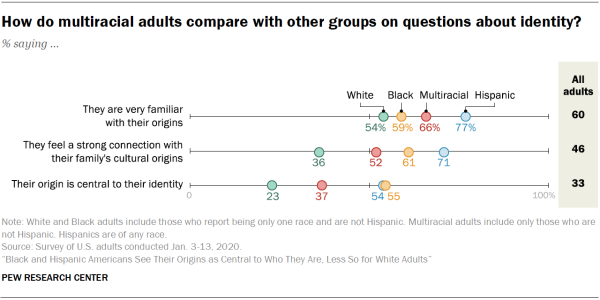
On questions about the strength or centrality of their origins, non-Hispanic multiracial adults had responses stating stronger connections than non-Hispanic single-race White adults and weaker ones than all Hispanic adults. For example, 37% said their origin is central to their identity, compared with 23% of single-race non-Hispanic White adults and about half or more of non-Hispanic single-race Black adults (55%) and all Hispanic adults (54%).
Most adults provided an origin in responding to questions like those asked on the census
The census two-step process first asked respondents whether they are Hispanic or Latino or of Spanish origin, and to specify which one, such as Mexican or Cuban. The next question asked respondents to identify their race from a list of categories, with more than one selection possible. Respondents who selected any race category had an opportunity to write in their origins, replicating the 2020 decennial census form and its addition of a write-in for White and Black origins with examples such as German or Ethiopian.1
On the Pew Research Center survey’s 2020 census questions, about nine-in-ten adults (88%) provided an origin as requested. Among Black and White respondents, who were only offered write-in areas, more White (82%) than Black respondents (61%) provided them. (About one-in-five who provided a usable White origin offered more than one, while only 2% of those who provided a usable Black origin did so.) Another 4% of White respondents and 23% of Black respondents provided a variation of “White” or “Black.” The rest did not answer. These White and Black respondents included some who were multiracial or Hispanic or both.
A variety of European origins dominated among respondents who selected White on the census race question and provided a usable response, with English, German or similar ancestries chosen by 84%. Among all Black respondents to the census race question and those who provided a usable response in the survey, 83% chose African American as their origin, rather than a specific country.
On the survey’s question from the 2020 census about Hispanic origin, 95% of Hispanics provided one, such as Mexican, Cuban or Salvadoran. In most cases it was a national origin.
The Census Bureau questions are not intended to measure the strength of Americans’ ties to their backgrounds. Consistent with this, even among those in the Pew Research Center survey who are very familiar with their origins, about a third (34%) said they do not feel a strong connection to them. For example, among White adults who are very familiar with their roots, 44% said they do not feel a strong connection.
Census question origin responses generally match self-descriptions, except among Hispanics
When asked to describe their race and ethnicity in their own words, about eight-in-ten respondents provided answers that could be mapped into standard Census Bureau categories. These included geography-based answers such as English, Chinese or Mexican, as well as racial or ethnic responses such as White/Caucasian, Native American or Hispanic.
But 18% of respondents did not provide an answer to the write-in race and ethnicity question, and smaller shares gave a protest response (see Chapter 2 text box) such as “none of your business.”
Among respondents who provided usable information, most gave answers to the self-description write-in and census questions that matched (90%) or partly matched (10%). But there were notable differences by demographic groups, with Hispanic respondents (who identified that way in the census questions) less likely to offer matched answers than single-race White or Black respondents.
About half of Hispanics who gave valid answers to both sets of questions (53%) had responses that matched, and about half (47%) provided answers that only partly matched. For example, some respondents described their race or ethnicity in the self-description question as “White” alone, but then indicated Hispanic in the census Hispanic question and White in the census race question. One cause of the partial match may have been that respondents were following survey directions. The race question similar to that asked on the 2020 census had asked respondents to provide their race and instructed: “For the purposes of this question, Hispanic origins are not races.”
This tracks other research that has found that many people consider their Hispanic heritage to be their race. Census Bureau research concluded that most Hispanics would not check a race category if offered a single question about race and Hispanic origin that did not require them to select a race. On the Pew Research Center survey, Hispanics also were less likely than White respondents to say that the census race and ethnicity questions reflect very well how they see their own race and identity. Fewer than half (44%) did, compared with about half of White (51%) and Black (52%) respondents.


